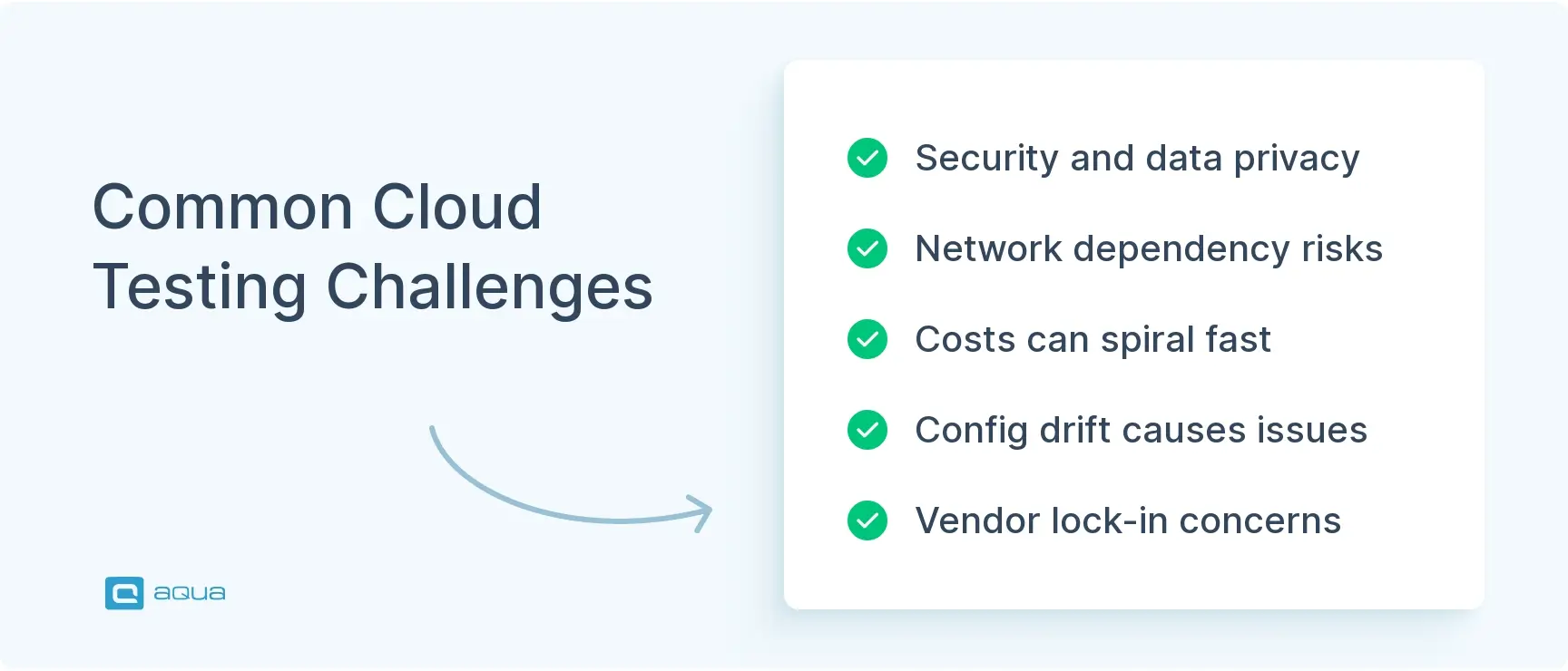Key Takeaways
- Cloud-based testing leverages virtual resources to execute tests across multiple environments, eliminating the need for expensive on-premises infrastructure while reducing costs by 60-70%.
- Test environments in the cloud follow three deployment models: public cloud for maximum scalability, private cloud for enhanced security, and hybrid cloud combining elements of both.
- Infrastructure as Code (IaC) enables teams to define their entire testing environment in code, eliminating configuration drift and ensuring testing consistency across team members.
- Key cloud testing types include functional testing across diverse environments, performance testing with virtually unlimited virtual users, security testing with specialized tools, and compatibility testing across devices.
- Cloud testing tools like aqua cloud, BlazeMeter, AWS Device Farm, and LambdaTest address different testing needs from automation to performance to browser compatibility.
Despite its benefits, cloud testing comes with challenges around security, network dependencies, and unexpected costs that teams must address with proper governance. Want to learn how to implement an effective cloud testing strategy for your organization? Read the full article below 👇
What is Cloud-Based Testing?
Cloud-based testing runs your tests on virtual infrastructure instead of physical machines in your office. You write tests normally, but they execute on remote servers that scale up or down based on what you need.
The practical difference shows up immediately. Need to test across five browser versions? Spin up five virtual environments instantly. Running load tests with 10,000 simulated users? The infrastructure scales to match without you buying hardware. Your London tester and Singapore developer use identical test environments without setup conflicts or configuration drift.
This matters because physical infrastructure creates bottlenecks. Your team can only run as many tests as your hardware supports. Peak testing periods mean waiting while other tests finish. Cloud testing tools eliminate these problems by making capacity elastic instead of fixed.
The testing itself covers everything you already do: functional tests, performance validation, security scans, and compatibility checks across browsers and devices. What changes is removing infrastructure as a limitation. Tests that would run sequentially on local machines now run in parallel across dozens of virtual environments, turning hours of testing into minutes.
Benefits of Cloud-Based Testing
Moving testing to the cloud changes what’s possible with your QA process in ways that matter for both speed and budget. Let’s break the benefits down, one by one.
Infrastructure Costs Drop Dramatically
Traditional testing means buying servers, maintaining hardware, and paying for capacity that sits idle most of the time. Cloud based testing tools flip this model. You pay only when tests actually run. Need intensive load testing for two weeks before a major release? Spin up massive infrastructure for those two weeks, then scale back down. This pay-as-you-go approach can cut testing infrastructure costs by 60-70% while actually improving what you can test. Some teams report ROI exceeding 500% within the first year simply by eliminating hardware they no longer need to own.
Testing Speed Multiplies Through Parallelization
Sequential testing is slow testing. When you can only run tests one at a time on limited hardware, comprehensive test suites take hours or days to complete. Cloud platforms let you run hundreds of tests simultaneously across multiple virtual machines. Tests that took eight hours running sequentially finish in twenty minutes when parallelized across cloud infrastructure. This speed directly affects how often you can test and how quickly developers get feedback.
Geographic Distribution Becomes Simple
Want to know how your application performs for users in Tokyo, London, and São Paulo? Cloud testing lets you execute tests from data centers in those regions, revealing real network latency and performance characteristics your users will experience. Distributed teams also benefit since everyone accesses identical test environments regardless of location. The “works on my machine” problem disappears when everyone’s machine is actually the same virtual environment.
Device and Browser Coverage Expands Without Limits
Testing across twenty browser versions and fifty device models used to mean maintaining a device lab and constant hardware upgrades. Cloud test tools provide instant access to virtual devices and browsers without physical hardware. Need to verify your app works on an obscure Android device from three years ago? It’s available in the cloud. This coverage extends testing reach dramatically compared to maintaining physical devices.
Scalability Matches Actual Needs
Your testing needs fluctuate. Pre-release periods demand intensive testing. Between releases, testing activity drops. Cloud infrastructure scales with these patterns automatically. Simulate 10,000 concurrent users one day, then scale down to minimal resources the next. You pay for what you use rather than over-provisioning for peak scenarios that happen occasionally.
These benefits explain why teams switching to cloud-based testing rarely go back. But the cloud isn’t just one testing approach. Different types of cloud testing solve different problems, and understanding which type fits your needs determines whether the transition actually delivers these benefits.
As you consider migrating your testing infrastructure to the cloud, one of the biggest challenges is finding a solution that can truly unify your testing processes while taking advantage of cloud flexibility.
This is where aqua cloud stands out from traditional test management approaches. Unlike basic tools that simply move your existing problems to the cloud, aqua provides a comprehensive platform specifically designed for cloud-based testing workflows. The platform’s centralized repository unifies both manual and automated tests in one place, keeping testing assets accessible to team members regardless of location, whether they’re in London or Singapore. Aqua’s AI Copilot generates test cases from requirements in seconds, saving up to 97% of the time traditionally spent on test creation. Native integrations with Jira, Azure DevOps, and Confluence connect seamlessly to your existing cloud infrastructure and workflows. For organizations managing complex environments, aqua’s flexible configuration supports unlimited scalability across diverse cloud setups while maintaining full traceability between requirements, tests, and defects.
Transform your testing operations with cloud-native test management that delivers real results
Key Types of Cloud-Based Testing
Cloud testing isn’t one thing. Different types solve different problems, and most teams need several of them working together.
Functional Testing Across Environments
Functional testing verifies features work as designed. Cloud platforms make this practical across dozens of browser and device combinations without maintaining physical hardware. Testing a payment flow? Verify it works on Chrome Windows, Safari macOS, and twenty mobile devices simultaneously. Cloud-based testing tools provide instant access to these environments, letting you validate functionality anywhere users might access your application.
Performance Testing at Real Scale
Performance testing shows its true value in the cloud. Traditional setups struggle to simulate realistic load, because you’re limited by available hardware. Cloud testing tools generate thousands of virtual users hitting your application from multiple geographic regions. Want to see how your system handles Black Friday traffic? Spin up 50,000 simulated users for an hour, identify the bottlenecks, then scale back down. This kind of load testing was previously impossible without massive infrastructure investment.
Security Testing With Current Threats
Security testing finds vulnerabilities before attackers do. Cloud-based security tools stay updated with latest threat information and can scan applications for known vulnerabilities automatically. Running these tests in isolated cloud environments means you can safely attempt penetration testing and exploit detection without risking production systems.
Compatibility Testing Across Everything
Compatibility testing ensures your application works regardless of how users access it. Cloud platforms maintain libraries of browser versions, devices, and operating systems that would cost hundreds of thousands to replicate physically. Testing how your checkout works on an obscure Android device from 2019? The cloud provides access without buying outdated hardware.
Specialized Testing Types
Beyond these core areas, cloud testing covers API validation, regression testing to catch broken functionality after code changes, load testing under expected conditions, and stress testing to find breaking points. Most teams combine several types based on what matters for their application.
The question isn’t whether to use cloud testing. It’s figuring out which types deliver the most value for your specific situation and when the transition makes practical sense.
When to Use Cloud Testing
Cloud testing makes sense in specific situations. Knowing when it delivers actual value versus when traditional testing works fine saves you from migrating for the wrong reasons.
Scaling Applications Under Real Load
Your user base is growing fast or you’re launching in new markets. Can your infrastructure actually handle the traffic? Cloud testing lets you simulate realistic usage at scale before users hit production. An e-commerce site preparing for holiday traffic can verify it handles ten times normal transaction volume without buying permanent infrastructure for temporary peaks.
Testing Microservices Architectures
Microservices create complex testing scenarios with multiple services, dependencies, and integration points. Cloud environments replicate these distributed architectures accurately, letting you test service interactions and failure recovery under realistic conditions. Local testing environments rarely capture this complexity.
Supporting CI/CD Pipelines
Continuous delivery demands automated testing that keeps pace with frequent code changes. Cloud test tools integrate with CI/CD pipelines to run tests automatically after each commit. This constant feedback loop catches issues while they’re fresh rather than days later when context is lost.
Validating Global Performance
Applications serving users worldwide need testing from multiple geographic locations. Cloud testing reveals how network latency, regional infrastructure, and content delivery affect user experience in Tokyo versus São Paulo. This insight is impossible to get from testing in one location.
Covering Device and Browser Combinations
Need to test across fifty browser and device combinations? Cloud platforms provide instant access without maintaining physical device labs. This matters especially for consumer applications where users access your site from countless configurations.
Cloud testing also fits scenarios like seasonal businesses with fluctuating testing needs, teams with limited in-house testing infrastructure, or organizations migrating to cloud-based infrastructure. The common thread is situations where traditional testing hits practical limits around scale, coverage, or speed. Understanding these scenarios helps decide not just whether to use cloud testing, but how to set up the right testing environment.
Cloud testing by itself doesn't mean much but there are a variety of testing infrastrucures backed by cloud based services, such as visual testing, or "self healing" machine learning frameworks.
Cloud Testing Environment Setup
Setting up effective cloud testing environments means understanding what you’re actually building and why each piece matters.
Core Infrastructure Layers
Cloud testing environments stack in three layers:
- Infrastructure provides computing through virtual machines, containers, or serverless resources
- Middleware includes databases, messaging systems, and caching that support your application
- Application layer contains your actual software plus dependencies and configurations
Getting these layers right determines whether tests reflect reality or just pass in artificial conditions.
Deployment Models
Choose based on your security and scale needs:
- Public clouds (AWS, Azure) offer maximum scalability with minimal management overhead
- Private clouds provide dedicated resources with tighter security for strict compliance requirements
- Hybrid combines both, keeping sensitive testing private while using public clouds for massive load tests
Infrastructure as Code
Manually configuring test environments wastes time and creates drift between runs. Tools like Terraform or CloudFormation let you define infrastructure as code. Spin up identical environments automatically, tear them down when done, version control everything. This eliminates “it worked in my test environment” problems.
Configuration Realities
Your test environment needs to mirror production:
- Network conditions should simulate actual user connections, not ideal data center speeds
- Test data must represent real scenarios without exposing sensitive information
- Security parameters should match production settings
- Container tech like Docker makes these configurations portable across platforms
Management Essentials
Effective environments also need:
- Service virtualization for simulating unavailable dependencies
- Test data management that respects privacy regulations
- Monitoring to capture performance metrics during execution
- Cost controls that automatically deallocate unused resources
Poorly configured environments produce passing tests that don’t reflect production behavior. Well-configured environments catch real issues before users do.
Creating Test Cases for Cloud Testing
Writing test cases for cloud environments isn’t much different from traditional testing, but cloud characteristics change what you need to verify and how you structure tests.
Start With What Actually Matters
Define clear objectives tied to real business requirements. A cloud-based checkout flow needs to verify basic functionality, yes, but also how it behaves when infrastructure scales dynamically or when accessed from Tokyo with 200ms latency versus London with 20ms. Cloud testing means accounting for conditions that don’t exist in fixed local environments.
Handle Test Data Realistically
You need diverse data sets that cover real scenarios without exposing sensitive information. Many teams use data masking or generate synthetic data that looks realistic but isn’t actual customer information. Volume matters too. Testing a reporting feature with 100 records tells you nothing about performance with 10 million records. Your test data should reflect production scale, not development convenience.
Design for Automation From the Start
Cloud testing shines when automated. Structure test cases to be:
- Idempotent so they produce identical results every time they run
- Independent so they don’t rely on state from previous tests
- Parallel-ready so hundreds can execute simultaneously
Include proper setup and teardown that provision and clean up cloud resources automatically. Leaving resources running after tests finish burns money for no reason.
Test What Happens When Things Break
Cloud services occasionally degrade or fail. Does your application handle temporary database unavailability gracefully? Do retry mechanisms work? Does circuit breaking prevent cascading failures? These chaos engineering-style tests reveal whether your application survives real cloud conditions or falls apart under stress.
Structure Tests for Multiple Environments
Tests should run against development, staging, and production with minimal changes. Parameterize environment-specific details like endpoints, credentials, and resource configurations. Hard-coding values means rewriting tests for every environment, which nobody actually does consistently.
Cover Cloud-Specific Concerns
Your test cases also need to verify:
- Performance across different geographic regions
- Behavior under varying load conditions as infrastructure scales
- Resource utilization to prevent cost surprises
- API interactions since cloud applications depend heavily on them
- Security controls including identity management and access restrictions
- Configuration variations to ensure the application works regardless of cloud service settings
The goal isn’t writing more tests. It’s writing tests that actually verify cloud behavior matters, like dynamic scaling, geographic distribution, and resilience to infrastructure issues that only appear in cloud environments.
Challenges in Cloud Testing
Cloud testing solves problems but creates new ones. Understanding what can go wrong helps you prepare instead of discovering issues mid-project. It’s time to break down the challenges.

Security and Data Privacy
Testing needs realistic data, which often means sensitive information subject to regulations. Moving customer data to cloud environments for testing creates risk. Public clouds share infrastructure with other organizations, amplifying concerns. You need robust encryption, clear data governance policies, and careful evaluation of cloud provider security certifications. Many teams solve this with data masking or synthetic data generation, avoiding real customer information in test environments entirely.
Network Dependencies Create Blind Spots
Cloud testing relies on internet connectivity. Any disruption interrupts tests or produces misleading results. Network latency affects reliability, especially for performance-sensitive applications. Tests that pass perfectly in cloud environments sometimes behave differently in production due to networking variations. The fix involves network simulation, baseline metrics that account for expected variations, and tests designed to distinguish application issues from network problems.
Configuration Drift Kills Consistency
Dynamic cloud environments change constantly. Without governance, tests produce inconsistent results from environment drift or undocumented changes. The multitude of configuration options makes reproducing specific test conditions difficult. Infrastructure-as-code practices, detailed documentation, and containers help maintain consistency, but require discipline to implement properly.
Costs Spiral Without Controls
Cloud testing reduces overall expenses until it doesn’t. Forgotten test instances running overnight, inefficient resource allocation, and data transfer costs accumulate quickly. Teams need automated cleanup after testing completes, proper resource tagging, and automatic shutdown policies for non-production environments during off-hours. Without these controls, cloud testing becomes more expensive than the on-premise infrastructure it replaced.
Other Real Problems
Tool integration gets complex when connecting testing tools with cloud platforms. Finding people with both testing expertise and cloud infrastructure knowledge is difficult. Vendor lock-in concerns grow when you depend on specific cloud provider features. Compliance verification across different jurisdictions adds complexity. Performance variability in shared environments makes results inconsistent. Distributed teams across time zones struggle with coordination.
These challenges aren’t reasons to avoid cloud testing. They’re reasons to plan carefully and implement proper controls from the start. Teams that ignore these issues discover them expensively in production.
Best Practices for Cloud Testing
Following proven practices helps you actually get value from cloud testing instead of just moving problems to a different infrastructure.
Treat Infrastructure as Code
Define your entire testing environment as code that can be version-controlled and deployed automatically. Virtual machines, networks, databases, and security settings, all described in files managed like application code. Tools like Terraform or CloudFormation let you spin up identical environments on demand, eliminating “works on my machine” inconsistencies. A financial services team might maintain separate templates for compliance testing, performance testing, and security testing, each with appropriate resources and controls. When tests finish, tear down environments with the same code that built them.
Test Early and Often
Integrate cloud testing throughout development instead of treating it as a final gate before production. Cloud environments make continuous testing practical by providing on-demand resources whenever developers or QA need them. Early testing catches issues when they’re cheap to fix. Configure CI/CD pipelines to automatically provision test environments, run appropriate tests, and report results without manual intervention. Developers get feedback in minutes instead of waiting for scheduled test cycles.
Monitor Everything That Matters
Implement application performance monitoring that captures detailed metrics during test execution: response times, resource usage, error rates. These insights reveal bottlenecks and optimization opportunities you’d otherwise miss. Maintain detailed logs of test activities, environment configurations, and results for troubleshooting. Dashboards showing key metrics help teams track progress and make informed decisions about release readiness based on data instead of gut feelings.
Control Costs Automatically
Automate provisioning and deprovisioning so you only pay for resources during actual testing. Schedule resource-intensive tests during off-peak hours when cloud costs drop. Use spot instances for non-critical testing to reduce expenses further. Set budget alerts that notify you when costs approach thresholds. Review resource utilization regularly to find optimization opportunities like rightsizing virtual machines or consolidating parallel runs. Teams that skip cost controls discover cloud testing isn’t cheaper, just differently expensive.
Other Critical Practices
Implement proper test data management with generation, masking, and cleanup procedures that respect privacy regulations. Incorporate security testing into standard pipelines instead of treating it separately. Break down silos between development, QA, and operations to improve collaboration. Apply chaos engineering principles by deliberately introducing failures to verify resilience. Invest in training to build cloud testing expertise within your team rather than depending on external consultants. Maintain comprehensive documentation of processes, environments, and configurations so knowledge doesn’t live only in people’s heads.
These practices compound over time. Teams that implement them early see increasing returns as testing scales. Teams that skip them spend more time firefighting issues than actually testing.
Best Cloud Testing Tools
The right cloud test tools dramatically improve testing efficiency and coverage. Here are the platforms worth considering based on what you actually need to test.
aqua cloud
Aqua cloud combines test management with cloud-based execution in one platform designed for distributed teams. The platform’s AI capabilities generate comprehensive test cases in seconds, accelerating testing cycles while improving coverage. Native integrations with Jira, Jenkins, and major automation frameworks connect seamlessly to existing cloud infrastructure and CI/CD pipelines. What sets aqua apart for cloud testing is complete visibility through customizable dashboards and real-time collaboration features including commenting, notifications, and shared workspaces. Unlimited scalability ensures the platform grows with your needs, while comprehensive audit logs maintain compliance in regulated industries. Teams get centralized test management with the flexibility to execute tests across any cloud environment.
Achieve 100% test coverage and 97% faster test creation with aqua's cloud-native test management
Best for: Organizations needing unified test management solutions that scale with cloud infrastructure.
BlazeMeter
BlazeMeter specializes in performance and load testing at massive scale. Simulate millions of virtual users from different geographic locations to verify your system handles realistic traffic patterns. The platform supports various testing protocols and provides detailed performance analytics that identify bottlenecks. Teams can reuse existing JMeter scripts without managing the infrastructure complexity typically associated with large-scale performance testing.
Best for: High-traffic applications requiring extensive performance and stress testing.
AWS Device Farm
AWS Device Farm provides access to real physical devices for mobile application testing. Test on the latest devices and operating system versions without maintaining an in-house device lab that becomes outdated quickly. Supports automated frameworks like Appium and XCTest, plus manual testing capabilities. Integrates naturally with other AWS services if you’re already in that ecosystem.
Best for: Mobile-focused development teams, especially those using AWS infrastructure.
LambdaTest
LambdaTest enables testing across 3000+ browser and operating system combinations through automated and manual approaches. Real-time testing lets you interact directly with remote browsers, while screenshot testing quickly verifies rendering across multiple configurations. Integrations with test automation frameworks, bug tracking tools, and CI/CD systems create seamless workflows.
Best for: Cross-browser web applications needing compatibility verification.
LoadRunner Cloud
LoadRunner Cloud offers enterprise-grade performance testing with comprehensive analytics and script reuse capabilities. The platform provides detailed insights into application behavior under load with tools specifically designed for performance-critical business applications.
Best for: Large organizations with mission-critical applications requiring extensive performance analysis.
Accelq
Accelq provides no-code test automation with AI-driven test maintenance. The platform’s business-friendly interface makes it accessible to teams with limited coding expertise while still delivering robust automation capabilities.
Best for: Teams wanting automation without extensive programming requirements.
| Tool | Primary Focus | Key Strength | Pricing Model |
|---|---|---|---|
| aqua cloud | Test management + execution | AI-powered test generation, unlimited scalability | Flexible subscription |
| BlazeMeter | Performance & load testing | Massive scale, geographic distribution | Usage-based |
| AWS Device Farm | Mobile app testing | Real physical devices | Pay per device minute |
| LambdaTest | Browser compatibility | 3000+ browser combinations | Subscription tiers |
| LoadRunner Cloud | Enterprise performance testing | Advanced analytics | Enterprise licensing |
| Accelq | No-code automation | AI-driven maintenance | Per user pricing |
When selecting cloud based test management tool options, evaluate integration capabilities with your existing toolchain, support for your specific technologies, and pricing models aligned with your usage patterns. Most providers offer free trials and let you verify suitability before committing.
Conclusion
Cloud-based testing eliminates the infrastructure bottlenecks that slow traditional QA. It provides scalable resources on demand and enables parallel test execution that turns hours of testing into minutes. The change from maintaining physical servers to using cloud test tools isn’t just about cost savings, though eliminating hardware expenses matters. It’s about matching testing capacity to actual needs instead of being limited by what you own. After implementing cloud based automation testing with proper controls around security, cost management, and environment consistency, you’ll get faster feedback loops, better test coverage, and the flexibility to scale your testing.

















